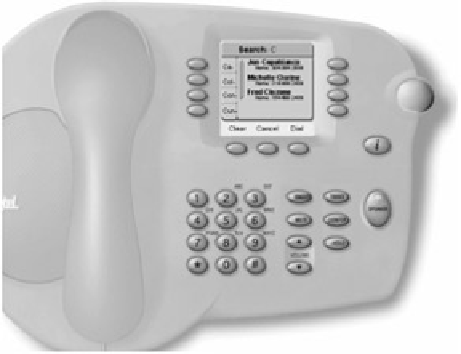Database Reference
In-Depth Information
Small-Screen Display: Pingtel xpressa Phone Interface
Contributions by Hal Shubin, Rich Schaaf
Pingtel is the creator of xpressa, a high-tech telephone. The xpressa phone has a user interface—a
small grayscale LCD display. In addition to the usual set of telephone buttons, the xpressa phone has
11 buttons around the display whose functions change depending on the context (
Figure 2.6
).
Figure 2.6:
The production version of the xpressa phone and a close-up of its LCD display.
Pingtel was developing this phone and its user interface in 1999. The team had written specifications to
document the flow of the screens but hadn't nailed down the interface yet. The designers wanted to
make the phone interface intuitive, but in some cases they had what seemed to be equally viable ideas
about how to implement functionality. During the design phase a number of questions arose, for
example:
Would users adopt an object-verb approach (for example, looking up a number first and then
dialing it) or verb-object approach?
Which was the easier method of searching for stored phone numbers—scrolling through the entire
list or a divide-and-conquer method using the left-hand buttons to divide the list into successively
smaller chunks? (See
Figure 2.7
.)
Figure 2.7:
One of the paper prototype screens used in testing the search functionality, where
users were asked to look up Mary Connolly's home number. The function of the 11 physical
buttons around the display depends on context; in this example the four right-hand buttons are
not used.
Should they create novice and advanced modes, where only a subset of functionality would be
available by default and the user would need to explicitly access the more advanced functions? Or
would this just be confusing?
The right answers weren't obvious, and the product team didn't want to waste time implementing the
wrong approach. They could have mocked up a version of the interface in software, but this would have
taken some time. Besides, they believed it was important to see how users interacted with the physical
















Search WWH ::

Custom Search